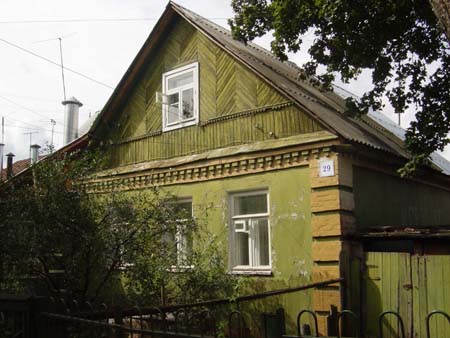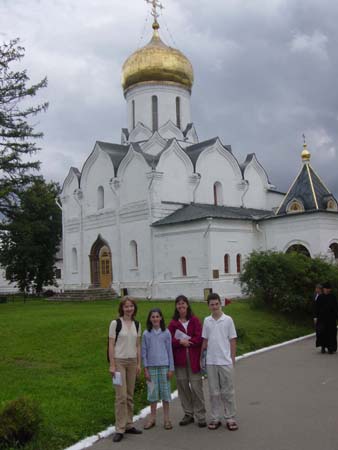Friday, August 22
Paula: Today we planned to spend outside of the city of Moscow to get a feel for how Russians live in the countryside. We arranged with Anna to hire a car and driver to take us to a typical Russian town where tourists never visit. After considering a variety of alternatives, we decided to visit Zvenigorod, a small town located about 50 miles west of Moscow. This ended up being a perfect place to visit.
Zvenigorod is a small medieval town, and was founded in the 12th century.
It lies along the Moskva River, and is a quiet community whose main attraction
is the Savvino-Storozhevsky Monastery located about 2 miles away. As we arrived
and made arrangements with the driver to be picked up later, he asked Anna
why Americans would want to visit such a small and sleepy town - after all,
there are no attractions here! Anna assured the driver that this was in fact
the place we wanted to visit for the day.
We started by doing some food shopping in a typical Russian food store. There
are no grocery stores here - everyone shops in very small (1 room) markets
where all the food products are located on shelves behind the service counter.
We also stopped in a "department store" which again is a very small
shop that sells a very wide variety of products for the home. The store sells
housewares, clothing, toiletries, snacks, small appliances, etc. - however,
there's basically only one item to choose from in each category. 
Zvenigorod also has an outdoor market selling produce, meat, herbs, flowers
and a variety of clothing and footwear. It's a very quiet and friendly market,
and feels like the kind of place where people like to go to see each other
to talk and catch up. David and Katie especially enjoyed seeing the local
meat market, complete with a pig's head sitting on the counter and people
chopping meat with large axes behind the counter.
We walked through the town center, stopping to look at the homes on the street.
Anna said that the homes are very typical of the "dachas" (country
homes) that many Russians own as second residences. Some of the homes appeared
to not have running water - this is typical of the dachas. The homes appeared
comfortable and very simple. They're also built very close to each other -
Anna explained that the older dachas located in the countryside often have
more space, including gardens and yards.
We also visited the Orthodox Church in the town and a small shop next to
it selling religious icons. The church was small inside with only a few benches
and Anna told us that in the Orthodox Church you are not allowed to sit during
the services. There was also a large WWII memorial in the town center - Zvenigorod
is the closest that the Germans got to Moscow during the war.
We walked to the Savvino-Storozhevsky Monastery. It was a nice walk along
a river and there were many residents also heading to the monastery to complete
religious rituals. The women wore long skirts with scarves over their heads.
On our way we also discovered the old Kremlin (fortress) of the town and climbed
the small hill on which it was located. The fortress wall was no longer apparent;
however there were still two Orthodox Churches next to each other and a small
collection of homes.  One
of the churches was established in the 14th century. Anna also told us that
the churches (both of the same faith) were close together because they are
used for different purposes-one for prayers, another for services. We also
learned that the city's name Zvenigorod means ringing city and that the fortress
and its bell tower were often used to warn Moscow of incoming invaders.
One
of the churches was established in the 14th century. Anna also told us that
the churches (both of the same faith) were close together because they are
used for different purposes-one for prayers, another for services. We also
learned that the city's name Zvenigorod means ringing city and that the fortress
and its bell tower were often used to warn Moscow of incoming invaders.
The monastery was quite lovely and also set on a hill with a pretty view of the countryside below. We had a nice picnic lunch provided by Anna before heading into the monastery to visit the church and museums. The museums contain artifacts and original articles used in the monastery which was established in 1339. The environment is quiet and peaceful. Monks in their long black robes roamed the walkways and we appeared to be the only tourists. The kids especially enjoyed meeting and petting the many cats on the grounds. Katie commented that it had been almost 8 weeks since she had been able to hear gentle purrs, and we all realized how much we miss our own cats. Before leaving, we purchased a small hand-carved wooden box with the town's name. It was carved out of birch which will remind us of the birch trees surrounding the monastery.
We returned to the hotel with Anna, and David and Katie enjoyed showing her photos of our home in the U.S. before we had to say good bye. Anna was a wonderful guide and host, and really helped us enjoy our stay in Moscow. We learned so much about Russian life by spending time with her and hope she will visit us in Boston someday soon. Her kind heart and warm personality helped us feel very welcome in Moscow.
Distance Walked: 2.71 miles
